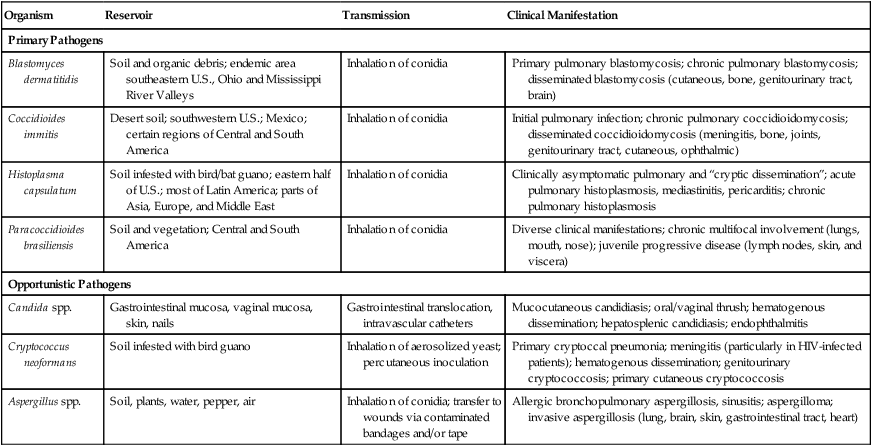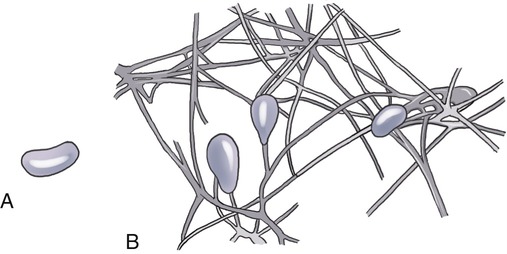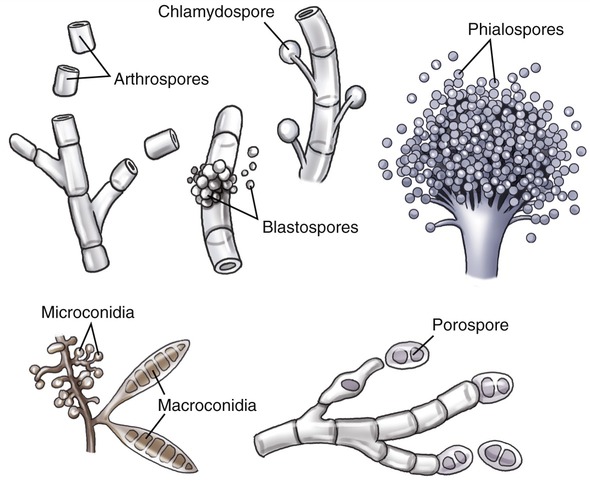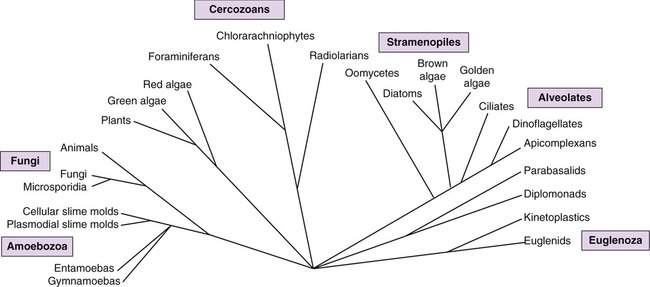Eukaryotic Microorganisms
After reading this chapter, the student will be able to:
• Describe, compare, and differentiate the characteristics of fungi, algae, protozoans, and helminths
• Describe the defining characteristics of fungi and explain the difference between their sexual and asexual reproduction
• Identify the medically important fungi
• Name the defining characteristics of algae, classify them, and describe the difficulties in their classification
• Describe the general characteristics of asexual and sexual reproduction of algae
• Identify the three defining and the common characteristics of protozoans
• Describe the general life cycle of protozoans and explain the importance of the macro- and micronucleus
• Discuss the fundamental differences between cellular and plasmodial slime molds
• Describe the main characteristics of parasitic helminths
• Describe the life cycles of flukes, tapeworms, and roundworms, and classify them into the appropriate categories
Introduction
Eukaryotic organisms differ from bacteria and archaea in many ways including cell size, internal structure, and genetic properties (see Chapter 3, Cell Structure and Function). The classification of eukaryotes has changed over the centuries starting in the late eighteenth century with Linnaeus, who classified all organisms as either plants or animals. At present, instead of the traditional classification schemes, many taxonomists favor classification schemes that are based on distinguishing characteristics at the molecular level. Modern taxonomy attempts to explain the genetic relationships of microbes and place them in groups based on similarities in their biochemical and metabolic characteristics, their nucleotide sequences, as well as their cellular ultrastructure as revealed by electron microscopy. Although universal support for a particular classification scheme has not been reached, many taxonomists favor a scheme similar to the one shown in Figure 8.1.
Fungi
The study of fungi is called mycology, and although more than 100,000 species of fungi are known, only about 200 are pathogenic to humans and animals, and relatively few fungi are virulent enough to be considered primary pathogens (Table 8.1). Moreover, the incidence of fungal infections has been increasing, especially those acquired in hospitals (nosocomial), other institutional settings such as nursing homes, and in people with a compromised immune system.
TABLE 8.1
Primary and Opportunistic Fungal Pathogens
| Organism | Reservoir | Transmission | Clinical Manifestation |
| Primary Pathogens | |||
| Blastomyces dermatitidis | Soil and organic debris; endemic area southeastern U.S., Ohio and Mississippi River Valleys | Inhalation of conidia | Primary pulmonary blastomycosis; chronic pulmonary blastomycosis; disseminated blastomycosis (cutaneous, bone, genitourinary tract, brain) |
| Coccidioides immitis | Desert soil; southwestern U.S.; Mexico; certain regions of Central and South America | Inhalation of conidia | Initial pulmonary infection; chronic pulmonary coccidioidomycosis; disseminated coccidioidomycosis (meningitis, bone, joints, genitourinary tract, cutaneous, ophthalmic) |
| Histoplasma capsulatum | Soil infested with bird/bat guano; eastern half of U.S.; most of Latin America; parts of Asia, Europe, and Middle East | Inhalation of conidia | Clinically asymptomatic pulmonary and “cryptic dissemination”; acute pulmonary histoplasmosis, mediastinitis, pericarditis; chronic pulmonary histoplasmosis |
| Paracoccidioides brasiliensis | Soil and vegetation; Central and South America | Inhalation of conidia | Diverse clinical manifestations; chronic multifocal involvement (lungs, mouth, nose); juvenile progressive disease (lymph nodes, skin, and viscera) |
| Opportunistic Pathogens | |||
| Candida spp. | Gastrointestinal mucosa, vaginal mucosa, skin, nails | Gastrointestinal translocation, intravascular catheters | Mucocutaneous candidiasis; oral/vaginal thrush; hematogenous dissemination; hepatosplenic candidiasis; endophthalmitis |
| Cryptococcus neoformans | Soil infested with bird guano | Inhalation of aerosolized yeast; percutaneous inoculation | Primary cryptoccal pneumonia; meningitis (particularly in HIV-infected patients); hematogenous dissemination; genitourinary cryptococcosis; primary cutaneous cryptococcosis |
| Aspergillus spp. | Soil, plants, water, pepper, air | Inhalation of conidia; transfer to wounds via contaminated bandages and/or tape | Allergic bronchopulmonary aspergillosis, sinusitis; aspergilloma; invasive aspergillosis (lung, brain, skin, gastrointestinal tract, heart) |

Fungi have important symbiotic relationships with other organisms and therefore can be beneficial to life in general. For example, they play a major role in the decomposition of dead plant material, and they are the primary decomposers of material such as cellulose, which cannot be digested by animals. The majority of plants are dependent on their symbiotic relationship with mycorrhizae (fungi that help the roots of plants to absorb minerals and water from the soil). Fungi provide food for humans in the form of mushrooms and truffles, and they are used in the manufacture of foods and beverages, including breads, alcoholic beverages, citric acid, soy sauce, and some cheeses. Fungi also produce pharmaceuticals such as the antibiotics penicillin and cephalosporin (see Chapter 22, Antimicrobial Drugs, for details). In addition, fungi are of use in the making of the immunosuppressive drug cyclosporine for organ transplant patients, and mevinic acids, which are used in the manufacture of cholesterol-reducing drugs. Fungi are also important research tools in genetics and biotechnology (see Chapter 25, Biotechnology).
Characteristics of Fungi
Fungi are eukaryotes but are quite different from plants and animals. Fungal colonies are vegetative structures because they are made up of cells involved in catabolism and growth. Whether microscopic or macroscopic, they generally grow as filamentous, multinucleated organisms that form threadlike filaments called hyphae, or as unicellular fungal organisms (Figure 8.2, A). Morphologically, fungi are often divided into three groups.

Fungi can exist as (A) unicellular organisms, or (B) form a mycelium, a mass of hyphae that continues to grow.
Most fungi that are identified as human pathogens are microscopic. Hyphae are long, branching filamentous cells of a fungus and they represent its main vegetative growth. A collective mass of the threadlike hyphae is called the mycelium (Figure 8.2, B). A mycelium can be small, forming colonies too small to see with the naked eye, or they can be extensive, such as Armillaria gallica, which was described as extending through 37 acres of forest soil and was estimated to weigh at least 9700 kg.
• Fungi tend toward maximal growth in a somewhat acidic environment, at about pH 5, which is too acidic for the growth of most bacteria (with such exceptions as Helicobacter pylori, which likes to grow at the pH of the human stomach [see Chapter 12, Infections of the Gastrointestinal System]).
• Most fungi are more resistant to osmotic pressure than are bacteria and can grow in relatively high concentrations of sugar or salt.
• Fungi can grow on substances with low moisture content, too low to support bacterial growth.
• Fungi metabolize more complex carbohydrates than bacteria.
• Chitin synthesis and other compounds for use in the cell wall, materials that induce hypersensitivity (see Chapter 20, The Immune System)
• Ergosterol synthesis for the plasma membrane, making the plasma membrane susceptible to antimicrobial agents targeting ergosterol synthesis or ergosterol incorporation into the plasma membrane (see Chapter 22, Antimicrobial Drugs)
Fungal pathogens can be classified on the basis of their growth forms—filamentous, yeast, or dimorphic—and on the type of infection they can cause. For example, in superficial mycoses, the fungus grows on the surface of the skin or hair. In cutaneous and subcutaneous mycoses, nails and deeper layers of the skin are involved, and in systemic (deep) mycoses, the fungus spreads to internal organs (Box 8.1). Patients with a compromised immune system are especially susceptible to fungal infections. Whereas superficial and cutaneous mycoses are generally mild, systemic mycoses are serious and difficult to treat.
Yeasts
Yeasts exist as single cells that reproduce by budding. However, some species may become multicellular through the formation of connected budding cells referred to as pseudohyphae, or true hyphae (Figure 8.3). They can be classified according to the presence or absence of capsules, the size and shape of the cells, the mechanism of daughter cell formation, formation of hyphae, presence of sexual spores, and other physiological/genetic data. Yeasts may require oxygen for their metabolic activities as obligate aerobes or may be able to continue their metabolic activities in the absence of oxygen as facultative anaerobes. Yeasts do not require light for their growth.
Molds
Molds are rapidly growing, asexually reproducing fungi that grow on a variety of substances. They are characterized by the development of hyphae (long filaments of cells joined together), which results in colony characteristics that can be used for identification purposes. Hyphae can grow to immense proportions (see Armillaria gallica, earlier this chapter). In general, the hyphae in molds contain cross-walls called septa, which divide the hyphae into distinct uninuclear, cell-like units called septate hyphae. Some classes of fungi have coenocytic hyphae, which do not contain septa and appear as long, continuous cells with many nuclei (Figure 8.4). In an appropriate environment, the hyphae grow to form a mycelium that is visible to the naked eye.
Dimorphic Fungi
• As a mold with septate hyphae in their natural reservoir (i.e., soil) and in the laboratory when incubated at 25° C on conventional fungal media
• As yeast in tissues of a human or other animals or in the laboratory when incubated at 37° C on enriched media (i.e., brain heart infusion agar)
Several dimorphic fungi can cause systemic mycoses (see Table 8.1) that usually start by the inhalation of spores from the mold form and then germinate in the lungs, where the fungus grows as yeast. These fungi include, but are not limited to, Sporothrix schenckii (sporotrichosis), Histoplasma capsulatum (histoplasmosis), Blastomyces dermatitidis (blastomycosis), Paracoccidioides brasiliensis (paracoccidioidomycosis), and Coccidioides spp. (coccidioidomycosis).
Life Cycle of Fungi
Asexual Reproduction
Yeast typically bud in a manner similar to the binary fission of prokaryotic organisms (see Chapter 3, Cell Structure and Function; and Chapter 6, Bacteria and Archaea). Filamentous fungi can reproduce asexually by fragmentation of their hyphae, and by spore formation either sexually or asexually. Asexual reproduction results in the formation of sporangia, which ultimately release spores into the environment. Spores, after entering the respiratory tract, are common causes of infection (see Chapter 11, Infections of the Respiratory System). These asexual spores are often categorized on the basis of the nature and manner of spore development:
• Sporangiospores form inside a sac, the sporangium, which is attached to a stalk, the sporangiophore, located on the tips or sides of hyphae. The spores are released when the sporangium ruptures.
• Conidia (conidiospores) are produced at the tips or sides of hyphae but are not enclosed by a saclike structure. Their development involves the pinching off of the tip of a fertile hypha or the segmentation of a preexisting vegetative hypha. They are the most common of the asexual spores and exist in different forms (Figure 8.5):

• Arthrospore: A rectangular spore, formed when a septate hypha breaks at the cross wall
• Chlamydospore: A spherical conidium produced by the thickening of a hyphal cell that is released when the surrounding hyphae crack
• Blastospore: A spore that buds from a parent cell
• Phialospore: A spore that buds from the mouth of a vase-shaped, spore-bearing cell
• Microconidium and macroconidium: Spores formed by the same fungus under different conditions, either as one cell (microconidium) or as two or more cells (macroconidium)
• Porospore: A spore that grows out through small pores in a spore-bearing cell





